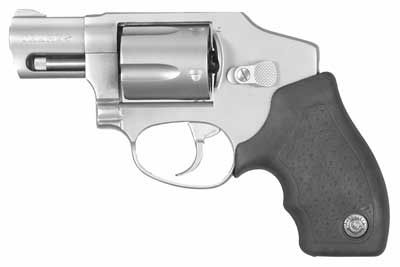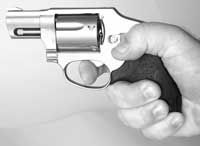Courtesy

For carry purposes, a short-barreled (snub-nosed) revolver has many welcome attributes, including ease of concealment, maneuverability, ease of presentation, and comfort. The short barrel makes the gun easy to hide and handle, and having smooth surfaces can help minimize incidental contact during carry that can irritate or scrape one’s skin. One such gun is the .38 Special +P Taurus CIA, which has an enclosed hammer like the Centennials.
As well as with regular cartridges, we tested with Strike Three ammunition from Advance Tactical Firearms of Las Vegas, Nevada, (702) 362-7750. These rounds are multiple-projectile cartridges that disperse upon ignition. Whereas frangible ammunition disperses on impact, Strike Three sends three different slugs downrange separately with every shot. Hence our five-shot groups printed 15 different holes. The three projectiles consist of two spheres and a disc that we weighed out to be a total of approximately 116 grains. Effective range is described by the manufacturer (Armscor of the Philippines) as being zero to fifteen yards.
The Taurus CIA revolver is as close a straight-out copy of the Smith & Wesson Centennial revolver as you can get. This was a fortunate choice, because by emulating the the Centennial series, Taurus picked up on one of Smith & Wesson’s best designs. The main difference in design between the two is that while Smith & Wesson limits the use of a coil mainspring to their smallest J-frame models, this system is used throughout the Taurus lineup.
The CIA is an all-steel revolver, so naturally it is heavier than the 360S or any of the alloy revolvers available today. At 27 ounces it could be considered a heavyweight among five-shooters, ranked by weight neatly between the Smith & Wesson 640 Centennial and the Ruger SP101. However, these other guns are chambered for .357 Magnum, and the CIA, despite being listed in numerous publications as a magnum revolver, is chambered for .38 Special only.
Its finish is matte stainless throughout, and its two-inch barrel is shadowed by a full underlug that is cut away to completely enshroud the ejector rod. Lockup is aided by a spring-loaded detent on the crane, a feature becoming standard on all Taurus revolvers. We couldn’t help but notice that the spring rate on this detent pin is much heavier than on the other Taurus models we’ve tested.
Gun Tests

The rubber grip completely encloses the frame and does a very good job of aiding the shooter’s hold and insulating it from blast. The supplied sights, which consist of a channel cut into the top strap and a serrated ramp, gave us a usable sight picture despite not being presented in contrasting colors. A key lock at the top of the backstrap locks the firing mechanism.
We found this model to be one of the best Taurus revolvers to date. The trigger is typical Centennial in feel and response. That is, its long stroke can be pulled straight through or staged. In this case, staging creates a moment of pause where the shooter can enact a separate press similar to single action. Our accuracy data was collected using a slow but consistent press without staging. While both the 360S AirLite SC and the Taurus CIA liked the Black Hills 125-grain +P ammunition best, the CIA proved more accurate, shooting the smallest group overall at 1.5 inches for an average of 1.9 inches measured center to center. The CIA was also way ahead firing Winchester’s 150-grain lead round nosed bullet, a respectable 3.0 inches at 15 yards. Velocity from this all-steel gun was substantially higher as well. With limited barrel length, the extra 75, 94, and 160 fps that the CIA produced from the Winchester, Black Hills and Strike Three cartridges respectively should come in handy.
Of course, the CIA will not fire the .357 Magnum, but going to this cartridge for a small gun is never a pleasant experience for the shooter. In firing the multiple-projectile Strike Three cartridges, the collective group size was almost half that of those fired from the Smith & Wesson. But, is a smaller group preferable in this case? To say yes would mean that we prefer that the energy be carried further and delivered in a more concentrated manner. Certainly, this would read that the effective range of the Strike Three ammunition fired from the Taurus CIA is measurably further than in the case of shooting the Smith & Wesson 360S. The CIA proved to be 100 percent reliable with all ammunition without a hint of failure to ignite.

























